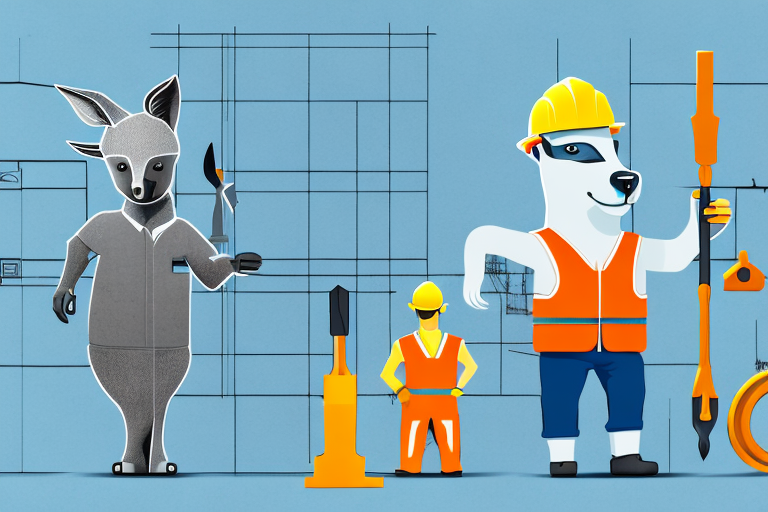If you’re planning to hire and pay contractors in Australia, it’s crucial to familiarize yourself with the ins and outs of the process. Whether you’re a small business owner or a project manager, understanding the legalities and best practices will help you navigate the complexities involved. This comprehensive guide will provide you with the knowledge you need to successfully hire and pay contractors in Australia.
Contents
- Who is an Independent Contractor in Australia?
- How is an independent contractor in Australia different from an Employee?
- Labor Laws: Points to Keep in Mind Before Moving Ahead to Hire and Pay Contractors in Australia
- Penalties for Contractor and Employee misclassification in Australia
- Steps to Hire a Contractor in Australia
- Important Considerations for Hiring and Managing Contractors in Australia
- How to Convert an Independent Contractor in Australia to an Employee?
- Do’s and Don’ts of Designing an Independent Contractor Agreement Before You Move Ahead to Hire and Pay Contractors Australia
- How Payroll Works When You Move Ahead to Pay Contractors in Australia
- Tax Filing Requirements for Contractors in Australia
- How Do Contractors File Their Taxes?
- Best Ways to Pay Contractors in Australia
- Currency and Other Considerations to Pay Contractors in Australia
- Termination or extension terms for independent contractors in Australia
- Quick Wrap Up
- Frequently Asked Questions
Who is an Independent Contractor in Australia?
An independent contractor is an individual or business that provides services to another entity under a contract for services. They are not considered employees and work independently, being responsible for completing tasks and delivering results as agreed upon in the contract. Independent contractors may operate under their own Australian Business Number (ABN) and have control over how and when they perform their work. It’s essential to correctly classify individuals to avoid penalties and legal complications.
When it comes to defining an independent contractor in Australia, there are several key factors that one needs to consider.
1. Degree of Control
Firstly, an independent contractor must have a high degree of control over how they perform their work. Unlike employees who are typically given specific instructions and guidelines, independent contractors have the freedom to decide how they will complete their tasks and achieve the desired outcomes.
2. Equipment
Independent contractors are responsible for providing their own tools, equipment, and resources necessary to carry out their work. This means that they are not reliant on the entity they are providing services to for these materials. Instead, they are expected to have their own equipment and use it to fulfill their contractual obligations.
3. Benefits
Do note that independent contractors are not entitled to the same benefits and protections as employees. They do not receive paid leave, superannuation contributions, or workers’ compensation. Instead, they are responsible for managing their own finances and ensuring they have appropriate insurance coverage to protect themselves and their business.
It’s important to note that simply labeling someone as an independent contractor does not automatically make them one in the eyes of the law. The Australian Taxation Office (ATO) and other regulatory bodies will assess the working relationship between the parties involved to determine the true nature of the arrangement. If it is found that an individual has been incorrectly classified as an independent contractor when they should be considered an employee, there can be serious legal and financial consequences for the entity responsible.
In conclusion, being an independent contractor in Australia means having the freedom to control how and when you work, providing your own tools and resources, and taking on the financial responsibilities that come with running your own business. It’s crucial for both contractors and the entities they work for to understand the legal obligations and implications associated with this classification to ensure compliance with Australian employment laws.
Suggested Read: EOR India- A Detailed Guide on Employer of Record
How is an Independent Contractor in Australia Different from an Employee?
The distinction between an independent contractor and an employee in Australia is vital for legal purposes. While employees work under an employment contract with an employer, independent contractors are self-employed and perform services as agreed upon in a contractual arrangement. Contractors have more flexibility and control over their work, including the ability to subcontract or delegate tasks. They are also responsible for their own taxes and superannuation contributions.
When it comes to the relationship between an independent contractor and an employee, there are several key differences that are important to understand.
1. Level of Autonomy
One of the main distinctions is the level of control and independence that each party has in their work. While employees typically work under the direct supervision and control of their employer, independent contractors have more autonomy in how they carry out their tasks.
For example, an employee may have set working hours and specific instructions on how to complete their work, while an independent contractor has the freedom to determine their own schedule and methods. This flexibility allows contractors to take on multiple clients and projects simultaneously, which can be beneficial for those seeking a diverse portfolio of work.
2. Remuneration Frequency
Another significant difference between independent contractors and employees is the way they are remunerated. Employees are usually paid a regular salary or wage, often with additional benefits such as sick leave, annual leave, and superannuation contributions made by their employer. On the other hand, independent contractors are typically paid on a project or task basis, and they are responsible for managing their own finances, including paying their own taxes and contributing to their own superannuation fund.
3. Legal Rights and Protections
Furthermore, the legal rights and protections afforded to employees and independent contractors differ. Employees are entitled to various employment rights and benefits, such as protection against unfair dismissal, access to workers’ compensation, and the right to join a trade union. Independent contractors, however, are not covered by these same protections and must rely on the terms of their contractual agreement for any legal recourse.
It is also worth noting that the distinction between an independent contractor and an employee is not always clear-cut and can sometimes be a point of contention. The Australian Taxation Office (ATO) provides guidelines to help determine whether a worker is an employee or a contractor, taking into account factors such as the level of control, independence, and integration into the business. However, each case is assessed on its own merits, and there may be instances where the classification is open to interpretation.
In conclusion, while both employees and independent contractors play important roles in the Australian workforce, there are significant differences between the two. Understanding these distinctions is crucial for both employers and workers to ensure compliance with the relevant laws and regulations. Whether you are considering engaging an independent contractor or seeking employment, it is essential to seek professional advice to ensure you understand your rights and obligations under the law.
Recommended Read: Independent Contractor Agreement for USA
Labor Laws: Points to Keep in Mind Before Moving Ahead to Hire and Pay Contractors in Australia
Moving ahead to hire independent contractors in Australia and lacking clarity in the various aspects of Australian labor laws is a big no-no.
In Australia, the Fair Work Act 2009 and the Fair Work Ombudsman form the foundation of the labor laws here. Let’s have a look at the various essential components that are intricately involved with the entire process of hiring contractors in Australia, and beyond.
Standard Workweek
The standard workweek in Australia is 38 hours.
Minimum Wage Legislation: To Pay Contractors in Australia
To define in simple terms, a minimum wage refers to an employee’s base pay rate for ordinary or usual hours worked. Basically, it is dependent on the industrial instrument as applicable to their employment.
Presently, the National Minimum Wage for workers above 21 years in Australia is $23.23 per hour or $882.80 per 38 hour week. These very minimum wages form a part of the National Minimum Wage Order.
A modern award covers employees in the national workplace system. This award encompasses minimum wage, along with a bunch of terms and conditions, for employees servicing certain industries. The Fair Work Commission’s Expert Panels conducts review sessions annually to check the minimum pay rates that an employee receives.
Since independent contractors are not employees, the minimum wage rule doesn’t apply to them. Further, they don’t enjoy employee entitlements, such as sick leave, annual leave, and as mentioned, minimum wages. They are free to negotiate the payment amount they wish to charge in exchange of the service they render to their clients.
Workers Officially Recognized by Australia
Let’s see which 9 kinds of workers does Australia recognize:
- Full-time;
- Part-time;
- Fixed-term;
- Casual;
- Probation;
- Outworkers;
- Apprentices/Trainees;
- Shift workers;
- Daily hire & weekly hire
Special Law for Independent Contractors
Well, independent contractors in Australia have the support of authorities when things come to receiving their payment from clients on time.
The Independent Contractors Act 2006 has established a national unfair contracts remedy scheme for all independent contractors operating in Australia. Freelancers or contractors have the right to request a court to check, change or set aside a contract if it appears to be harsh or unfair.
National Employment Standards
National Employment Standards in Australia covers 11 minimum entitlements that are granted to every employee. As is obvious, these entitlements vary, depending upon the employment nature and industry. Let’s see what these are:
- Work hours;
- Flexible work culture;
- Entitlements related to parental leave and others;
- Annual leave;
- Public holidays;
- Long service leave;
- Personal & caretaker’s leave;
- Parental leave with other similar entitlements
- Community service leave;
- Casual conversion;
- Fair Work and Casual Work Information Statements
While independent contractors don’t have access to these entitlements, they lawfully have the right to secure protection under the following cases:
- Coercion;
- Adverse action;
- Abuses of freedom of association
Also Read: Foreign Independent Contractors: Guide to Best Practices
Penalties for Contractor and Employee Misclassification in Australia
Misclassifying workers can have serious consequences in Australia. If you wrongly classify an employee as a contractor, you may be liable for unpaid employee entitlements, including wages, superannuation, and leave entitlements. This can result in significant financial losses for both the employer and the employee. For the employer, it means having to pay back the unpaid entitlements, which can be a substantial amount depending on the duration of the misclassification and the number of affected employees. For the employee, it means being deprived of their rightful wages and benefits, which can have a detrimental impact on their financial well-being.
Moreover, misclassifying workers can also lead to legal repercussions.
1. Legal Action by Authorities
The Fair Work Ombudsman, the government agency responsible for enforcing workplace laws in Australia, has the authority to investigate and take legal action against employers who engage in employee misclassification. This can result in penalties and fines imposed on the employer, further adding to the financial burden.
2. Penalties
If you incorrectly classify a contractor as an employee, you may face penalties, fines, and back payments for unpaid entitlements. This can occur when an employer treats a worker as an independent contractor, but they should actually be classified as an employee under the law. The consequences of this misclassification can be severe for the employer, as they may be required to pay the worker’s unpaid entitlements, including wages, superannuation, and leave entitlements. In addition, they may also be liable for penalties and fines imposed by the Fair Work Ombudsman.
It’s crucial to understand the distinct characteristics and correctly classify workers to avoid potential legal and financial repercussions. The classification of workers as either employees or contractors is determined by a range of factors, including the level of control exercised over the work, the degree of independence, the provision of tools and equipment, and the ability to delegate work. It’s important for employers to carefully assess these factors and seek professional advice if they are unsure about the classification of their workers.
By ensuring proper classification, employers can not only avoid penalties and fines but also foster a positive work environment. When workers are classified correctly, they receive the appropriate entitlements and benefits, which can contribute to their job satisfaction and overall well-being. This, in turn, can lead to increased productivity and loyalty from employees.
Steps to Hire a Contractor in Australia
When hiring a contractor in Australia, it’s essential to follow a systematic approach to ensure a smooth process.
1. Define the Scope of the Project
Start by clearly defining the scope of the project or work and identifying the skills and qualifications required. This step is crucial as it sets the foundation for the entire hiring process. Take the time to carefully assess the specific needs of your project and determine the expertise necessary to successfully complete it.
2. Advertising the Job Role
Once you have a clear understanding of the project requirements, it’s time to advertise the role. Utilize various platforms such as online job boards, industry-specific websites, and social media to reach a wide pool of potential candidates. Craft a compelling job description that highlights the key responsibilities, desired qualifications, and any specific requirements unique to your project.
3. Prepare the Independent Contractor Agreement Before Kick-Starting Work
As candidates begin to apply, it’s important to have a contractor agreement in place. This document outlines the terms and conditions of the working relationship and protects both parties involved. Ensure that the agreement includes details such as the project deliverables, timelines, payment terms, and any other relevant clauses. By providing potential candidates with a contractor agreement upfront, you establish transparency and set clear expectations from the beginning.
4. Organize Interviews and Assessment Procedures
Once you have received applications and resumes, it’s time to move on to the interview and assessment stage. This step allows you to evaluate candidates’ suitability for the role and assess their skills, experience, and cultural fit. Prepare a list of interview questions that delve into their past projects, problem-solving abilities, and communication skills. Consider conducting both in-person and virtual interviews to get a comprehensive understanding of each candidate.
5. Conduct Reference-checking
After conducting interviews, it’s important to thoroughly check the references provided by the candidates. Contact their previous clients or employers to gather insights into their work ethic, reliability, and overall performance. This step provides valuable information that can help you make an informed decision.
6. Review the Terms and Conditions of the Independent Contractor Agreement
Once you have selected a contractor, it’s time to negotiate the contract. Review the terms and conditions with the chosen candidate and ensure that all key aspects are covered. Discuss the project deliverables in detail, establish realistic timelines, and agree upon payment terms. It’s crucial to have a comprehensive contract that protects both parties and minimizes the risk of any misunderstandings or disputes.
After the contract is finalized, ensure that both parties sign it and keep a copy for your records. This step solidifies the agreement and ensures that all parties are committed to fulfilling their obligations. Additionally, it’s advisable to obtain relevant insurances, such as public liability insurance, to protect against any unforeseen risks that may arise during the project.
Hiring a contractor in Australia requires careful planning, thorough assessment, and effective communication. By following these steps, you can increase the chances of finding a qualified and reliable contractor who will successfully complete your project.
Suggested Read: Invoice for Contractors
Important Considerations Before You Move Ahead to Hire and Pay Contractors in Australia
When it comes to hiring contractors in Australia, there are several critical considerations that can greatly impact the success of your projects. It is essential to go beyond the basic requirements and delve into the intricacies of contractor management to ensure a seamless and productive working relationship.
Check Whether Your Contractors Have the Required Licenses and Permits
One of the first and foremost considerations is to ensure that your contractors possess the necessary licenses, permits, and qualifications required to perform their work. This becomes particularly crucial when dealing with roles that involve specific industries or regulated activities. By thoroughly vetting their credentials, you can rest assured that your contractors are equipped with the expertise and knowledge needed to excel in their respective fields.
Set Clear Expectations
Qualifications alone are not enough to guarantee a successful collaboration. Setting clear expectations and maintaining open lines of communication are vital aspects of contractor management. Clearly define project goals, deliverables, and timelines, and ensure that these are effectively communicated to your contractors. Regular check-ins and progress updates will help keep everyone on the same page and minimize any potential misunderstandings.
Establish a Proper Performance Review Process
It is imperative to establish a robust process for monitoring and evaluating contractor performance. Regular performance reviews provide an opportunity to assess their work quality, adherence to deadlines, and overall professionalism. By conducting these evaluations, you can identify any issues early on and address them promptly, ensuring that projects stay on track and meet the desired outcomes.
Pay Heed to Workplace Health
While focusing on contractor performance is crucial, it is equally important to prioritize workplace health and safety. As an employer, you have a legal obligation to provide a safe working environment for both your employees and contractors. Implementing thorough safety protocols, conducting regular inspections, and providing appropriate training are essential steps to mitigate any potential risks.
Nurture a Healthy Work Culture
Fostering a positive and inclusive work culture can significantly contribute to the success of your contractor management efforts. Encourage collaboration, open dialogue, and mutual respect among all team members. By creating an environment where contractors feel valued and supported, you can enhance their motivation and productivity, ultimately leading to better project outcomes.
To sum up, hiring and managing contractors in Australia requires careful attention to detail and a comprehensive approach. By ensuring that your contractors possess the necessary qualifications, setting clear expectations, monitoring performance, prioritizing workplace health and safety, and fostering a positive work culture, you can maximize the potential of your contractor relationships and achieve successful project outcomes.
How to Convert an Independent Contractor in Australia to an Employee?
If you are pleased with the performance of contractors in Australia, you may consider rolling out a full-time offer to them. So, how does the entire process of converting contractors to employees look like? Let’s find out.
- Assess the employment relationship, ensuring it meets legal criteria for employee status.
- Draft an employment contract outlining terms such as salary, working hours, and benefits.
- Update payroll and taxation records, deducting appropriate taxes.
- Familiarize yourself with relevant awards and ensure compliance.
- Communicate the changes transparently with the individual, addressing any concerns.
- Consult legal or HR professionals if needed for guidance through the process.
The most dreadful thing while converting a contractor to an employee is committing the error of worker misclassification. Obviously, you won’t want to get caught in the whirlwind of lawsuits, penalties, fines, reputation tarnish, and whatnot. Therefore, the most secured way to convert an independent contractor into an employee is by using Asanify’s Global Contractor Management tool. It’s time to make things simple, swift, and hassle-free.
Recommended Read: Terminating a Contractor- Know How to End an Agreement Politely
Do’s and Don’ts of Designing an Independent Contractor Agreement Before You Move Ahead to Hire and Pay Contractors Australia
When engaging the services of a contractor, it’s crucial to have a clear and comprehensive independent contractor agreement in place. This agreement serves as a legal document outlining the rights, responsibilities, and expectations of both parties involved. It should include details such as scope of work, payment terms, intellectual property rights, confidentiality provisions, dispute resolution procedures, and termination clauses. Working with a legal professional or using an online template can help ensure your agreement is legally sound.
How Payroll Works When You Move Ahead to Pay Contractors in Australia
Paying contractors in Australia involves understanding the intricacies of payroll and compliance requirements. While contractors are responsible for their own taxes and superannuation contributions, you need to ensure you fulfill your obligations as an employer. This includes requiring contractors to provide you with a valid ABN and, in some cases, a Statement by a Supplier (SBS). It’s crucial to accurately report and withhold the correct amount of Pay As You Go (PAYG) tax for contractors and meet any payment and reporting deadlines set by the Australian Taxation Office (ATO).
When moving forward with paying contractors, you may choose to handle payroll internally or outsource it to a reputable payroll service provider. Doing so can simplify the process and help you stay compliant with all payroll and tax obligations.
Also Read: How to Pay Contractors in Your Business?
Tax Filing Requirements for Contractors in Australia
Contractors in Australia are responsible for meeting their own tax filing requirements. They must report their income and claim deductions on their individual tax returns. Moreover, it is essential that they lodge their tax returns with the ATO by the specified deadline, typically October 31st each year or later if they use a registered tax agent.
As an employer, you may need to provide contractors with a Payment Summary if you’ve withheld tax from their payments. Further, it is important to check if you have any additional formalities to complete, depending upon the country out of which your company is based. Didn’t quite get it? Well, let’s use an example to understand it.
Say, your organisation is based out of the US. In that case, you will need to have in place a W-8 BEN Form. This form will be used to establish the identity of those contractors residing out of the US as Non-Resident Alien. Affirming their right identity is crucial because they will be taxed differently. Since the services that a foreign contractor renders are completed solely in their country, the income earned by the contractor don’t get grouped under US-sourced income. Therefore, your company is not required to report payments made to the contractor to the IRS.
Do note that there are some rules in place that necessitate an employer to take care of a contractor’s superannuation. Let’s delve deep into this!
Superannuation: To Pay Contractors in Australia
While employers usually don’t need to pay for a contractor’s superannuation, certain conditions may make it mandatory for you to pay super to a fund for them. These conditions are:
- if the contractor is delivering labor for manual labor (inclusive of mental and artistic work), the contractor would then be considered to be an employee and you need to pay superannuation charges;
- if the contractor is performing the contract work (the work can not be delegated to someone else);
- if the contractor is working under a verbal or written contract
Regulations Governing Superannuation Charges: To Pay Contractors in Australia
- It is important that you make superannuation payments directly to the chosen superannuation fund of the contractor.
- Make sure to get your hands on a Superannuation Fund Choice Form from each of your eligible contractors. This form will enlighten you on the name of the fund, fund bank routing details, account numbers, and contract tax, among other vital information.
- The superannuation cost is charged at 10% of the contractor’s pay. You need to pay this amount separately, so no deduction from what the contractor is actually getting, is allowed.
- Making the payment of superannuation charges quarterly is the norm.
How Do Contractors File Their Taxes?
- Contractors take care of their tax obligations by themselves. However, it is mandatory for them to obtain a Tax File Number or TFN from the Australian Taxation Office or ATO.
- Tax is not held back unless an independent contractor fails to quote their Australian Business Number or ABN.
- It is mandatory for contractors running their businesses in Australia to register for the Goods and Services Tax or GST if their income surpasses the limit of $75,000.
Best Ways to Pay Contractors in Australia
In Australia, there are several ways to pay contractors, and the method chosen often depends on factors such as the nature of the work and the agreement between the parties involved. It’s important to consider factors such as convenience, cost, and security when choosing the best payment method. Some online platforms also offer features like tax reporting and invoicing, making it easier to manage contractor payments.
Currency and Other Considerations to Pay Contractors in Australia
When paying international contractors, it’s essential to consider currency exchange rates and any associated fees. Asanify offers the best FX rates for contractor payroll. Managing payouts to contractors is now simplified!
Stay aware of any tax implications when paying contractors based outside of Australia. Consulting with a tax professional or seeking advice from relevant government agencies can help ensure compliance and minimize any potential issues.
Also read: Employee Misclassification Guide
Termination or Extension Terms for Independent Contractors in Australia
When engaging independent contractors, it’s crucial to establish clear termination or extension terms. These terms should be outlined in the contract and specify the conditions under which either party can terminate the agreement. It’s advisable to consult with a legal professional to ensure your termination and extension clauses comply with relevant Australian employment laws and regulations.
Quick Wrap Up
In conclusion, hiring and paying contractors in Australia requires a comprehensive understanding of legal obligations, best practices, and compliance requirements. By correctly classifying workers, creating solid contracts, and fulfilling your payroll responsibilities, you can ensure a successful working relationship with independent contractors. Remember to stay up to date with any legislative changes and seek legal and accounting advice when needed.
Frequently Asked Questions: Pay Contractors in Australia
Q: Can I hire contractors without an ABN in Australia?
A: In most cases, contractors should have their own ABN. However, there are some exceptions when you can engage contractors without an ABN, such as when they work through a personal services company or if they’re working as an employee under the Pay As You Go (PAYG) withholding system.
Q: Do contractors need to have their own insurances?
A: Contractors are generally responsible for having their own insurances, such as public liability insurance. However, it’s important to confirm this requirement with each contractor and ensure they provide appropriate insurance coverage.
Q: What happens if I misclassify an employee as a contractor?
A: Misclassifying an employee as a contractor can have serious legal and financial consequences. If you misclassify a worker, you may be liable for unpaid entitlements, such as wages, superannuation, and leave. It’s important to correctly classify workers to avoid potential penalties and legal disputes.
Q: How often should I review a contractor’s performance?
A: Regular performance reviews are essential to monitor a contractor’s performance and ensure they are meeting the agreed-upon expectations. The frequency of performance reviews can vary depending on the nature and duration of the engagement, but we recommend that you conduct them at least annually.
Throughout this guide, we’ve covered the essential steps, considerations, and requirements involved in hiring and paying contractors in Australia. Remember, it’s always advisable to seek professional advice and stay up to date with the latest laws and regulations. This will further aid you to ensure compliance in every aspect of engaging contractors.
Not to be considered as tax, legal, financial or HR advice. Regulations change over time so please consult a lawyer, accountant or Labour Law expert for specific guidance.












![Read more about the article Recommendation letter: How to write a superb one? [Free HR Letter template]](https://asanify.com/wp-content/uploads/2022/04/blog-covers-2240-×-1500px-8-300x201.png)